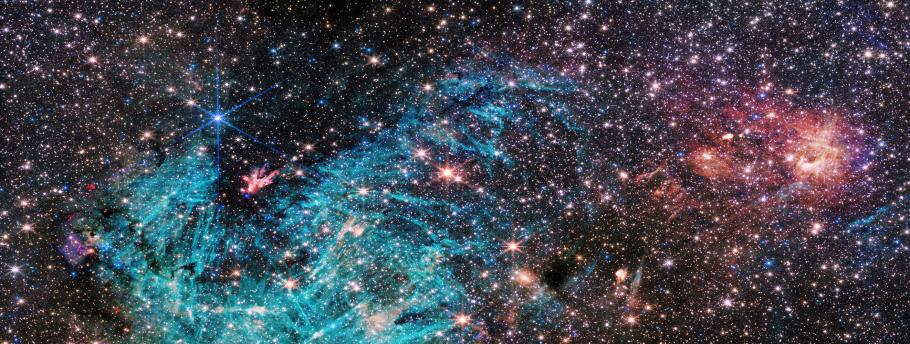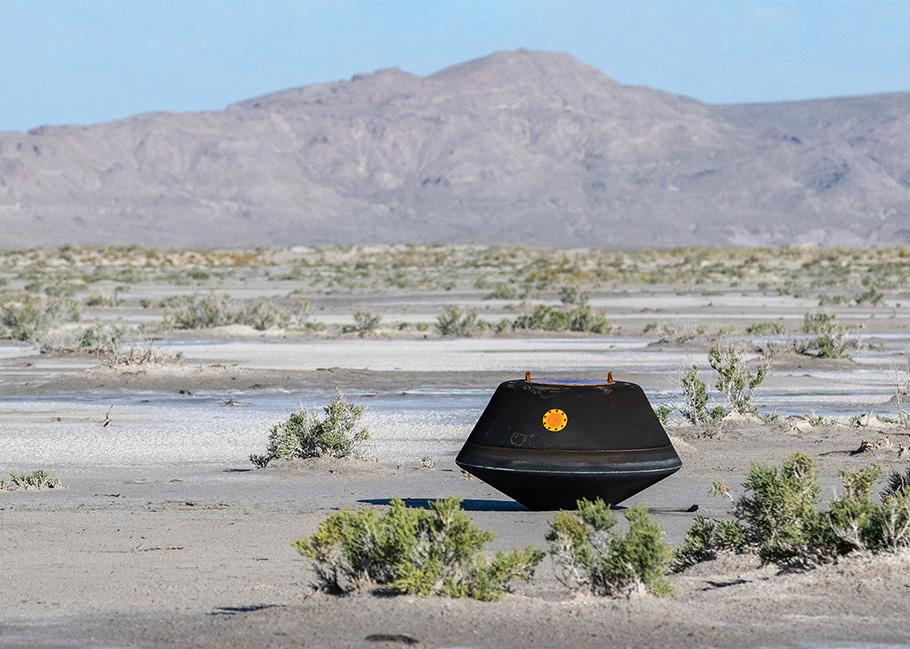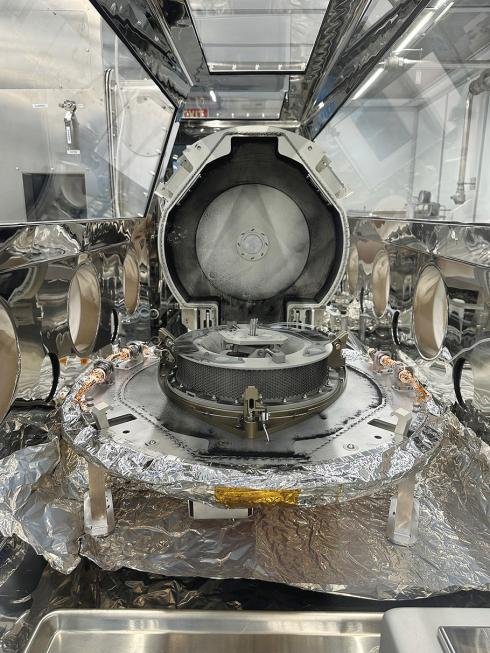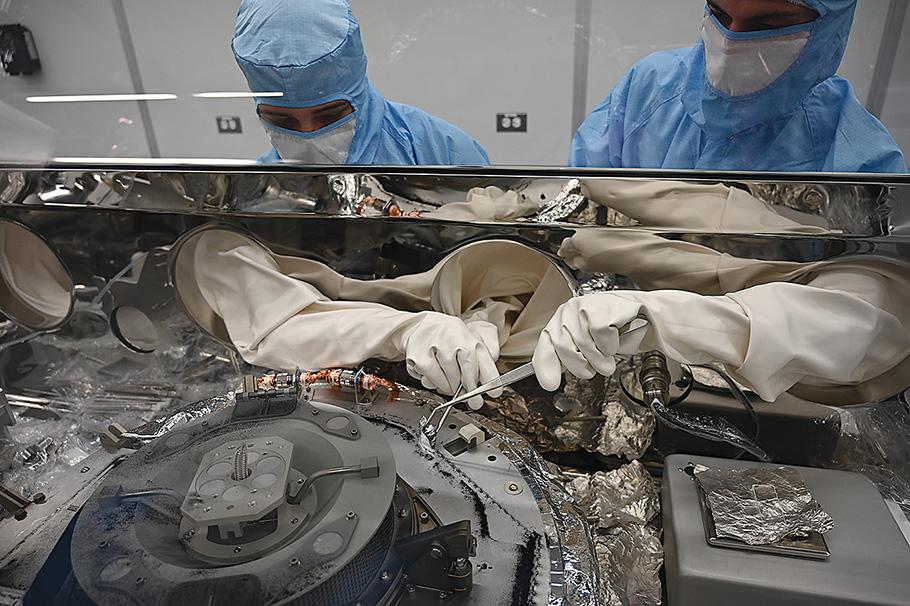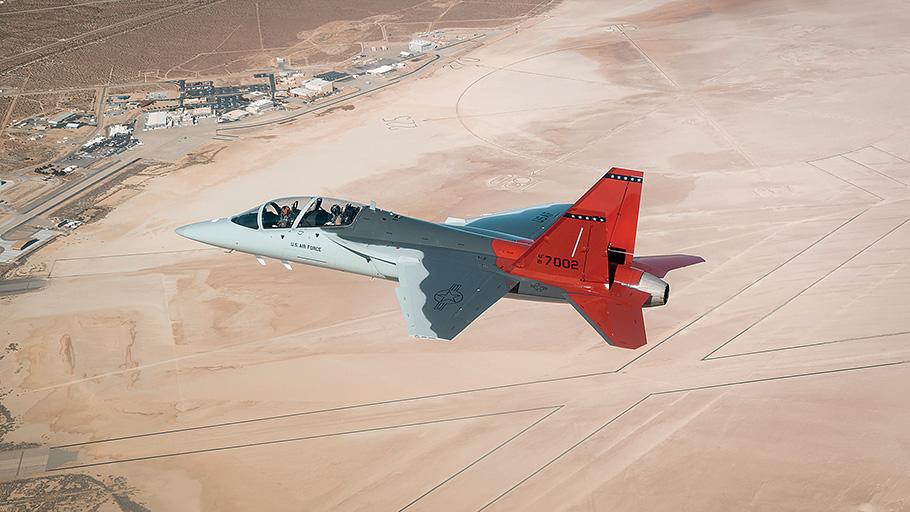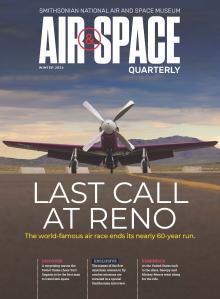The full view of the James Webb Space Telescope’s NIRCam (Near-Infrared Camera) instrument reveals a 50 light-years-wide portion of the Milky Way’s center. A vast region of ionized hydrogen, shown in blue, wraps around an infrared-dark cloud, which is so dense it blocks the light from distant stars behind it.
Postcard From Galactic Central
Astronomers explore an area of space packed with stars—and mysteries.
The James Webb Space Telescope has captured a stunning image of a chaotic region of space near the center of our galaxy—around 25,000 light years away from Earth—including never-before-seen features astronomers have yet to explain.
Launched on Christmas Day in 2021, the Webb Telescope is a gift that keeps on giving to astronomers. Designed to peer into the near-infrared spectrum, the powerful telescope, equipped with a mirror 21 feet in diameter, can see objects that were too faint or old to be seen by its predecessor, the Hubble Space Telescope.
This Webb image (above), released in November 2023, shows an area of space named Sagittarius C, located about 300 light-years from the Milky Way’s central supermassive black hole, Sagittarius A*. An estimated 500,000 stars are packed into this region, as well as a cluster of proto-stars, which are stars that are still forming and gaining mass. At the heart of the cluster is a massive proto-star over 30 times the mass of our sun.
Astronomers say that observing Sagittarius C provides an opportunity to test current theories of star formation, potentially yielding answers to such questions as whether massive stars are more likely to form near the galactic center rather than the galaxy’s spiral arms.
“Massive stars are factories that produce heavy elements in their nuclear cores, so understanding them better is like learning the origin story of much of the universe,” said Samuel Crowe, principal investigator of the Webb observations.
The image of Sagittarius C includes phenomena that astronomers, for the time being, are unable to explain. The blue cloud of ionized hydrogen, for instance, is likely the result of young and massive stars releasing energetic photons, but astronomers were surprised by the vast size of the region and say it warrants further investigation. Astronomers are also puzzled by needle-like structures in the ionized hydrogen, which appear oriented chaotically in many directions.
The sample return capsule landed safely in the Utah desert.
Space Rocks!
On September 24, 2023, the OSIRIS-REx spacecraft’s sample return capsule parachuted into the Utah desert, carrying precious material it had collected three years earlier from Bennu, a near-Earth asteroid more than 1,600 feet in diameter. Bennu is 4.5 billion years old and researchers hope that analysis of the samples will yield insights into the formation of our solar system.
Earlier generations of scientists who wanted to conduct direct analysis of the rocky objects in our solar system had to rely on meteorites that fell haphazardly to Earth. The advent of the space age has enabled a more direct approach, as missions—both human and robotic—collect and return samples from the moon, comets, asteroids, and, one day, other planets. The National Air and Space Museum’s 2024 Exploring Space Lecture Series will feature this topic through four lectures this winter and spring.
The lectures will explore how the lunar rocks brought back on the Apollo missions reshaped our understanding of Earth, the moon, and our solar system (March); how NASA brought back samples of Comet Wild-2 in 2006 on the Stardust mission (April 24); what scientists are discovering from the asteroid samples OSIRIS-REx recently returned to Earth (May 22); and what excites scientists most about the prospect of returning Martian samples from the Perseverance rover (June 5).
These programs will take place in person at the National Air and Space Museum in Washington, D.C., and streamed live on YouTube. Reserve free tickets now. The Exploring Space Lecture Series is made possible by the support of Aerojet Rocketdyne and United Launch Alliance.
The first T-7A Red Hawk soars over Edwards Air Force Base.
Aviators Get a New Ride
The first T-7A Red Hawk soared over Edwards Air Force Base in California on November 8, 2023. The Boeing T-7A will replace the 1960s-era Northrop T-38 by providing advanced pilot training capabilities for aviators learning to fly both tactical and bomber aircraft. The Red Hawk was named in honor of the Tuskegee Airmen, who painted the tails of their aircraft red and initially flew Curtiss P-40 Warhawks.
This article is from the Winter 2024 issue of Air & Space Quarterly, the National Air and Space Museum's signature magazine that explores topics in aviation and space, from the earliest moments of flight to today. Explore the full issue.
Want to receive ad-free hard-copies of Air & Space Quarterly? Join the Museum's National Air and Space Society to subscribe.

